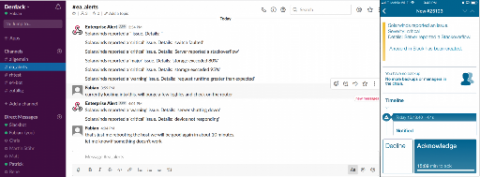Operations | Monitoring | ITSM | DevOps | Cloud
Latest News
COVID-19 Pandemic: How to Use AlertOps to Keep Your Enterprise Running
The coronavirus (COVID-19) pandemic has forced many global enterprises to temporarily shut down their operations, resulting in lost productivity and revenue losses. Yet, with a business continuity management (BCM) strategy, enterprises are well-equipped to limit business interruptions until the pandemic passes.
Incident Response in the time of Remote Work
Virtualizing a Network Operations Center
A Network Operations Center (NOC) is a location from which IT support technicians can supervise, monitor, and maintain client networks and infrastructure. Because they act as a central nervous system for many organizations, NOCs are typically located in a central physical location. The global coronavirus (COVID-19) pandemic is an unprecedented situation that is creating new challenges for everyone—and that includes NOCs.
Setting Up a Distributed Crisis Management Team for COVID-19? We Can Help
COVID-19 is forcing many teams into crisis mode, as they rush to meet customer and employee needs in our new socially distanced reality. Organizations with experienced crisis management teams are urgently adding capacity and adapting to distributed working models. And those who haven’t built crisis response teams before are grappling with how to rapidly train employees and get access to the right tools.
How to forward alerts to Slack
Ever since the release of our Teams Integration blog we have received requests from customers on whether we can provide the same functionality for Slack. And the use cases actually are very similar – it is always about an efficient and pragmatic approach to logging issues and tickets that came up during the night by leveraging existing infrastructure and without adding more clutter.
SRE for Business Continuity in the Face of Uncertainty
Schedule Rotations
Today, we are excited to announce PagerTree now officially supports schedule rotations! A long awaited feature and requested by many customers, with schedule rotations it’s now easier than ever to schedule a list (or “rotation”) of people for full coverage support. Schedule rotations are available on our Pro and Elite pricing plans and are technically a subset of our “recurring schedules” feature.
How to Avoid Alert Overload From EDR Solutions
In today’s chaotic digital sphere, networks are distributed across an increasingly wide range of hackable endpoints. From smartphones and tablets to Internet of Things (IoT) devices—everything gets connected to the network. EDR technologies and practices were created for the purpose of providing active endpoint protection and defense. However, if your systems and admins are overloaded with alerts, an EDR strategy might become obsolete.
5 tips for incident management when you're suddenly remote
A lot of teams are asking us about how to do incident management when you’re suddenly remote. We understand. Going remote can be scary, and few things are scarier than having a service outage you aren’t prepared for. Nobody wants to be in a situation where an important service is going down and the engineer who can help isn’t answering on Slack. And if your company isn’t used to working remotely, it can be harder than ever to be on the same page during an incident.











